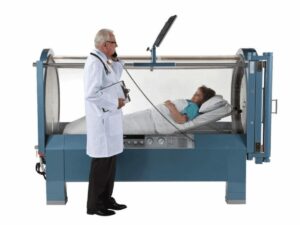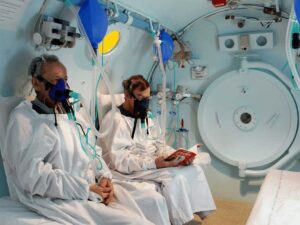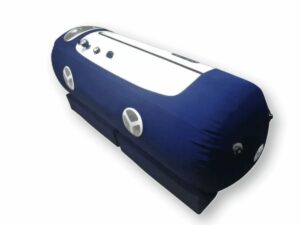Are you a business owner seeking to enhance your healthcare offerings? Understanding the world of hyperbaric chambers can be overwhelming with so many types available. In today’s competitive healthcare industry, staying informed about cutting-edge technologies like hyperbaric chambers is crucial for business growth and providing top-notch services to your clients.
Whether you’re already familiar with hyperbaric therapy or just starting to explore its potential, this comprehensive guide will equip you with the knowledge to make informed decisions for your business. We promise to unravel the complexities and offer valuable insights.
Read on and let’s dive into the world of hyperbaric therapy and discover which chamber suits your business needs best.
1. Understanding the Basic Principles
Hyperbaric chambers have revolutionized modern medical practices by harnessing the power of oxygen to accelerate healing and promote overall well-being. Let’s delve into the fundamental principles that underpin hyperbaric therapy.
Definition of Hyperbaric Chambers
Hyperbaric chambers are specialized medical devices designed to administer 100% pure oxygen to patients in a controlled environment with increased atmospheric pressure. By enabling patients to breathe oxygen at higher pressures than normal, hyperbaric chambers facilitate the dissolution of oxygen in bodily fluids, enhancing oxygen delivery to tissues, organs, and cells.
The Science Behind Hyperbaric Therapy
The therapeutic efficacy of hyperbaric therapy lies in its ability to harness oxygen’s healing properties. When a patient breathes pure oxygen under increased pressure, the concentration of oxygen in their bloodstream significantly rises. This excess oxygen triggers a series of physiological responses, such as increased production of growth factors and stem cells, reduced inflammation, and enhanced immune response.
Uses and Applications of Hyperbaric Chambers
The applications of hyperbaric chambers are wide-ranging and continue to expand as research uncovers new therapeutic potentials. Hyperbaric therapy is widely used to treat non-healing wounds, including diabetic ulcers and radiation injuries. Furthermore, hyperbaric chambers are increasingly employed to complement cancer treatments, manage certain neurological conditions, and aid in post-surgery recovery.
Potential Risks and Side Effects
While hyperbaric therapy is generally safe and well-tolerated, it is not without potential risks and side effects. Some individuals may experience ear and sinus discomfort due to pressure changes. Moreover, in rare cases, oxygen toxicity can occur, resulting in seizures. However, when administered by trained professionals and adhering to appropriate safety measures, the likelihood of adverse events is significantly reduced.
Overview of Different Types of Hyperbaric Chambers
At OxygenArk, our hyperbaric chambers are available in various configurations, each tailored to specific medical needs and patient capacities. From monoplace to multiplace, and even portable and veterinary chambers, the diversity of options allows healthcare providers to choose the most suitable chamber for their practice and clientele.
2. Monoplace Hyperbaric Chambers
Monoplace hyperbaric chambers are cutting-edge devices designed to provide hyperbaric therapy to one patient at a time. Here is a detailed exploration of monoplace hyperbaric chambers and their functionalities.

Definition of Monoplace Hyperbaric Chambers
Monoplace hyperbaric chambers, as the name suggests, are single-patient chambers that deliver pure oxygen at elevated atmospheric pressures. These chambers are typically transparent, allowing patients to observe their surroundings during the therapy session. The patient lies comfortably on a padded stretcher within the chamber, which is then sealed to create a pressurized environment conducive to the healing process.
Key Features
One of the primary advantages of monoplace chambers is their compact design, making them ideal for facilities with limited space. They are equipped with user-friendly controls that allow healthcare professionals to adjust pressure levels and treatment duration according to each patient’s unique requirements. They also come with built-in communication systems, enabling continuous monitoring and interaction with the patient.
Use Cases and Applications
Monoplace hyperbaric chambers find diverse applications in the medical field. They are highly effective in treating chronic non-healing wounds, diabetic foot ulcers, and radiation tissue injuries. Additionally, monoplace chambers are utilized to manage carbon monoxide poisoning, crush injuries, and certain neurological conditions like traumatic brain injuries and strokes.
Pros and Cons
One of the significant advantages of monoplace hyperbaric chambers is their cost-effectiveness, as they require fewer staff to operate and maintain. Their single-patient design ensures personalized treatment plans and minimizes the risk of cross-contamination. However, a potential drawback is they do not accommodate multiple patients simultaneously, which can limit treatment throughput in busy healthcare facilities.
3. Multiplace Hyperbaric Chambers
Multiplace hyperbaric chambers offer a unique approach to hyperbaric therapy by accommodating multiple patients at once, making them highly efficient for larger medical facilities. Here are the ins and outs of multiplace hyperbaric chambers:

Definition of Multiplace Hyperbaric Chambers
According to Hyperbaric Healing, multiplace chambers are very large and can hold more than one patient at a time. Unlike monoplace chambers, multiplace chambers are not transparent, ensuring privacy for patients during their therapy sessions. Medical personnel join the patients inside the chamber, making it feasible to administer treatments to those with limited mobility or who require medical supervision throughout the session.
Key Features
The spacious design of multiplace chambers allows for enhanced patient comfort during longer therapy sessions. The ability to treat multiple patients concurrently makes multiplace chambers a cost-effective solution for busy healthcare facilities, increasing treatment throughput and reducing patient wait times.
Use Cases and Applications
Multiplace hyperbaric chambers serve a wide range of therapeutic applications. They are frequently employed for treating divers suffering from decompression sickness, as well as patients with severe carbon monoxide poisoning and smoke inhalation injuries. Multiplace chambers are also invaluable in managing crush injuries, acute traumatic peripheral ischemia, and severe infections like necrotizing fasciitis.
Pros and Cons
The primary advantage of multiplace hyperbaric chambers is their ability to treat multiple patients simultaneously, significantly optimizing treatment efficiency. With medical personnel present inside the chamber, immediate medical intervention is possible in case of emergencies. However, the initial investment and operational costs for multiplace chambers are generally higher compared to monoplace chambers.
4. Portable Hyperbaric Chambers
Portable hyperbaric chambers have gained popularity in recent years due to their mobility and ease of use. Let’s discover the flexibility and convenience of portable hyperbaric chambers.

Definition of Portable Hyperbaric Chambers
Portable hyperbaric chambers are designed to provide hyperbaric therapy in a compact and transportable format. These chambers create a pressurized environment for patients to receive therapeutic levels of oxygen, similar to larger fixed chambers. The portability of these chambers allows for convenient transportation and setup in various locations, making them an attractive option for healthcare providers seeking flexibility.
Key Features
The standout feature of portable hyperbaric chambers is their mobility, enabling healthcare providers to offer hyperbaric therapy beyond the confines of a traditional medical facility. These chambers are made from durable materials that ensure a safe and controlled pressurized environment for patients. They come with user-friendly interfaces for easy pressure adjustments and treatment duration settings.
Use Cases and Applications
OxygenArk’s portable hyperbaric chambers are particularly beneficial in scenarios where patients may have difficulty accessing traditional medical facilities. They are commonly used in remote areas, disaster response situations, and military deployments. Additionally, these chambers are utilized by sports teams and athletes to aid in post-injury recovery and enhance overall performance.
Pros and Cons
The primary advantage of portable hyperbaric chambers is their versatility and ability to provide hyperbaric therapy in diverse settings. They are especially valuable in emergency situations and for patients who cannot easily travel to fixed hyperbaric facilities. However, due to their smaller size, portable chambers may not be suitable for patients who require medical supervision during treatment.
5. Veterinary Hyperbaric Chambers
Veterinary hyperbaric chambers have gained recognition for their efficacy in promoting the well-being of various animals. Let’s explore how hyperbaric therapy extends to the animal kingdom through veterinary hyperbaric chambers.

Definition of Veterinary Hyperbaric Chambers
Veterinary hyperbaric chambers are specially designed chambers that provide pressurized oxygen therapy to animals. These chambers cater to a wide range of animals. According to Hyperbaric Sac, it has been proven that the hyperbaric therapy used for medical treatments of human beings has the same extraordinary effects on animals as is it the case of equines and pets at home.
Key Features
Veterinary hyperbaric chambers are built with animal comfort and safety in mind. They are available in various sizes to accommodate animals of different species and sizes. The chambers feature sealed transparent doors or viewing windows, allowing veterinarians to closely monitor animals during the therapy session.
Use Cases and Applications in Animal Health
Veterinary hyperbaric chambers offer a range of applications to enhance animal health and well-being. These chambers are commonly used in treating wounds, infections, and inflammation in animals. They aid in post-surgical recovery, and support animals with respiratory issues. Moreover, veterinary hyperbaric chambers have shown promise in enhancing the recovery of racehorses and other performance animals.
Pros and Cons
One of the significant advantages of veterinary hyperbaric chambers is their ability to provide non-invasive and drug-free treatment options for animals. These chambers offer a safe and effective alternative for conditions that may be challenging to treat using traditional veterinary methods. However, the cost of acquiring and maintaining veterinary hyperbaric chambers can be a consideration for veterinary clinics and hospitals.
6. Comparison of Different Types of Hyperbaric Chambers
Selecting the right type of hyperbaric chamber depends on various factors. Here we present a comparison to assist in making an informed choice.
Design
Each type of hyperbaric chamber has a unique design catered to its purpose. Monoplace chambers are compact and ideal for individual treatments. In contrast, multiplace chambers are significantly larger, accommodating multiple patients, while portable chambers offer the advantage of mobility. Veterinary chambers are specially designed for treating animals, focusing on their comfort and safety.
Effectiveness and Applications
While all hyperbaric chambers operate under the same basic principle, their effectiveness can vary depending on the application. Monoplace and multiplace chambers, with their higher pressures, are generally more effective in treating serious medical conditions.
Safety Considerations
Safety considerations differ among the chamber types. Monoplace chambers require monitoring systems due to the patient being alone. Multiplace chambers require additional safety measures due to the increased number of people, while portable chambers need to be handled carefully to prevent damage. Veterinary chambers necessitate staff proficient in handling animals.
Cost and Investment
Cost considerations depend largely on your budget and purpose. For example, monoplace and portable chambers may cost less but are limited in their patient capacity. Multiplace chambers require a higher initial investment but can treat more patients concurrently, offering a higher potential return on investment. Veterinary chambers, due to their specialized nature, may require a significant investment.
7. 4 Factors To Consider When Choosing a Hyperbaric Chamber
The process of selecting the right hyperbaric chamber for your business involves several key factors. Here are some things to consider.
#1 Purpose and Use
The intended purpose and use of the hyperbaric chamber is a primary consideration. If the chamber is intended for a high-traffic hospital, a multiplace chamber that accommodates more than one patient may be ideal. For instance, a smaller clinic or home use, a monoplace or portable chamber might be more appropriate. Therefore, the specific use-case scenarios should be clear before making a choice.
#2 Size and Comfort
Size and comfort are crucial factors when considering a hyperbaric chamber. Depending on the available space in your facility and the comfort of your patients, you may opt for a smaller monoplace chamber or a larger multiplace one. Remember, patient comfort is paramount for effective treatment. Thus, ensure the chosen chamber provides adequate space for the patient to lie down or sit comfortably during the therapy session.
#3 Safety Features
Hyperbaric chambers, by their nature, are high-pressure environments, and safety should be of utmost importance. Essential safety features to look for include reliable pressure regulation systems, fail-safe door mechanisms, fire suppression systems, and clear observation windows or video monitoring systems for the staff to monitor the patient.
| Safety Feature |
Description |
| Pressure Monitoring |
Continuous pressure monitoring for safety. |
| Emergency Ventilation |
Automated system to release excess pressure. |
| Oxygen Monitoring |
Monitoring oxygen levels to prevent issues. |
| Transparent Walls |
Clear walls to monitor occupants during treatment. |
| Emergency Communication |
Communication system for emergencies. |
| Safety Interlocks |
Prevent chamber operation if safety conditions not met. |
| Certifications |
Compliant with relevant safety standards. |
#4 Budget Considerations
Hyperbaric chambers can be a significant investment, and it’s important to balance cost with quality, safety features, and patient capacity. Consider not just the upfront cost of the chamber, but also the potential ongoing operational and maintenance expenses. Weigh these against the potential benefits the chamber will bring to your facility in terms of patient outcomes and operational efficiency.
Dive Deeper Into Our Resources
For some insightful reads, we’ve curated a list of recommended articles just for you:
Still haven’t found what you’re looking for? Don’t hesitate to contact us. We’re available around the clock to assist you.
8. Conclusion
Understanding hyperbaric chambers – their principles, types, applications, and potential challenges – is crucial for making an informed decision. These versatile devices play a critical role in modern medicine, treating a variety of conditions and accelerating healing.
Should you consider investing in hyperbaric chambers, OxygenArk stands ready as a leading manufacturer to guide you through the selection process. With a wide range of high-quality hyperbaric chambers, they cater to diverse needs, from medical facilities to home care. For more details on hyperbaric solutions tailored to your business, contact OxygenArk today.




